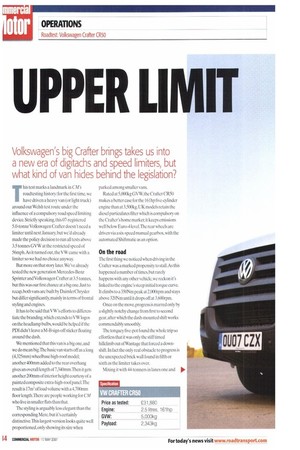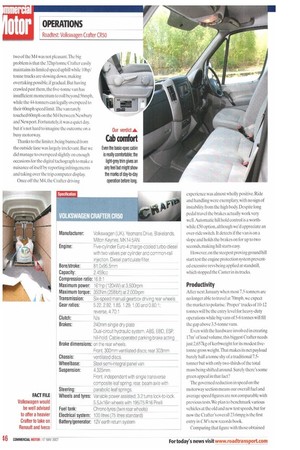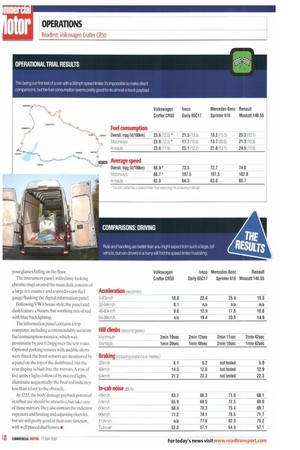UPPER L MIT
Page 44

Page 46

Page 47

Page 48

If you've noticed an error in this article please click here to report it so we can fix it.
Volkswagen's big Grafter brings takes us into a new era of digitachs and speed limiters, but what kind of van hides behind the legislation?
This test marks a landmark in CM'S roadtesting history: for the first time, we have driven a heavy van (or light truck) around our Welsh test route under the influence of a compulsory road speed limiting device, Strictly speaking, this 07-registered 5.0-tonne Volkswagen Crafter doesn't need a limiter until next January, but we'd already made the policy decision to run all tests above 3.5 tonnes GVW at the restricted speed of 56mph. As it turned out, the VW came with a limiter so we had no choice anyway.
But more on that story later. We've already tested the new generation Mercedes-Benz Sprinter and Volkswagen Crafter at 3.5 tonnes, hut this was our first chance at a big one.Just to recap, both vans are built by DaimlerChrysler but differ significantly, mainly in terms of frontal styling and engines.
It has to be said that VW's efforts to differentiate the branding, which extends to VW logos on the headlamp bulbs, would be helped if the PDI didn't leave a M-B sign-off sticker floating around the dash.
We mentioned that this van is a big one, and we do mean big.The basic van starts off as a long (4,325mm) wheelbase high-roof model; another 400rnm added to the rear overhang gives an overall length of 7,340mm.Then it gets another 200mm of interior height courtesy of a painted composite extra-high-roof panel.The result is 17m of load volume with a 4,700mm floor length.There are people working for CM who live in smaller flats than that.
The styling is arguably less elegant than the corresponding Mere, but it's certainly distinctive.This largest version looks quite well proportioned, only showing its size when parked among smaller vans.
Rated at 5,000kg GVW. the Crafter CR50 makes a better case for the 161hp five-cylinder engine than at 3,500kg. UK models retain the diesel particulates filter which is compulsory on the Crafter's home market; it keeps emissions well below Euro-4 level.The rear wheels are driven via a six-speed manual gearbox, with the automated Shiftmatic as an option.
On the road The first thing we noticed when driving in the Crafter was a marked propensity to stall.As this happened a number of times, but rarely happens with any other vehicle, we reckon it's linked to the engine's steep initial torque curve. It climbs to a 350Nrn peak at 2,000rpm and stays above 320Nm until it drops off at 3,600rprn.
Once on the move,progress is marred only by a slightly notchy change from first to second gear, after which the dash-mounted shift works commendably smoothly.
The torquey five-pot found the whole trip so effortless that it was only the stiff timed hillclimb out of Wantage that forced a downshift. In fact the only real obstacle to progress is the unexpected brick wall found in fifth or sixth as the limiter takes over.
Mixing it with 44-tonners in lanes one and two of the M4 was not pleasant.The big problem is that the 32hp/tonne Crafter easily maintains its limited speed uphill while 10hp/ tonne trucks are slowing down, making overtaking possible, if gradual. But having crawled past them, the five-tonne van has insufficient momentum to roll beyond 56mph, while the 44-tonners can legally overspeed to their 60mph speed limit.The van rarely touched 60mph on the M4 between Newbury and Newport. Fortunately, it was a quiet day, but its not hard to imagine the outcome on a busy motorway.
Thanks to the limiter, being banned from the outside lane was largely irrelevant. But we did manage to overspeed slightly on enough occasions for the digital tachograph to make a nuisance of itself by reporting infringements and taking over the trip computer display.
Once off the M4, the Crafter driving experience was almost wholly positive. Ride and handling were exemplary with no sign of instability from the high body. Despite long pedal travel the brakes actually work very well. Automatic hill hold control is a worthwhile £50 option, although we'd appreciate an over-ride switch. It detects if the van is on a slope and holds the brakes on for up to two seconds, making hill starts easy.
However, on the steepest proving ground hill start test the engine protection system prevented excessive revs being applied at standstill, which stopped the Canter in its tracks.
Productivity
After next January when most 7.5-tonners are no longer able to travel at 70mph, we expect the market to polarise:Proper' trucks of 10-12 tonnes will be the entry level for heavy-duty operations while big vans of 5-6 tonnes will fill the gap above 3.5-tonne vans.
Even with the hardware involved in creating 17m3 of load volume, this biggest Crafter needs just 2,657kg of kerbweight for its modest livetonne gross weight.That makes its net payload barely half a tonne shy of a traditional 7.5tonner but with only two-thirds of the total mass being shifted around. Surely there's some green appeal in that fact?
The governed reduction in speed on the motorway section means our overall fuel and average speed figures are not comparable with previous tests. We plan to benchmark various vehicles at the old and new test speeds, but for now the Crafter's overall 23.6mpg is the first entry in CM's new records book.
Comparing that figure with those obtained under the previous protocol, Renault's 5.5-tonne Mamma gave 23.3mpg, while most 7.5-tonners return in the region of 16-18mpg.
There's not a lot wrong with the big Crafter's loadspace. Full-height rear doors and a 1,300mm side-loading door give easy access for your load, even on pallets, and a phenolicresin floor and no less than a dozen tie-down rings keep it in place.The handy over-cab space reached from the load bay has a lined floor but no obvious points to hook a loadrestraining bungee.The test van also came with £355 of optional ply-lining kit.
Cab comfort
A plethora of light grey materials gives the Crafter's cab an airy feel, aided by the £50 optional window in the standard steel bulkhead. How it will look five years on is another matter.The driving seat has the lumbar support option, but even the basic spec is very comfortable. Thankfully, it has a wide range of adjustment, allowing a suitable driving position to be obtained despite the fixed steering column.
The column is topped by a multi-function steering wheel which is part of a £1,460 package with colour DVD sat-nay and an airbag. Only this and the combined lighting/ wiper stalk on the left betray the Mercedes heritage. Whatever the source, the interior has the quality feel that marks out both brands At first glance there isn't too much storage room in the Crafter cab,but it's actually rather Tardis-like.Tipping the passenger seat cushion forward reveals a pair of large areas,each capable of taking a decent sized rucksack or similar.There are reasonable door pockets and overscreen shelves,open trays and a partly lidded central compartment on top of the dash with a drop-down tray in the passenger seat backrest.The glovebox has no lock, but offers a pen and card-holder set by way of compensation.
Liquid refreshments can be accommodated in open holders at each end of the dash, or in a heavily engineered pop-out device built into the ashtray module.
in the tradition of the old I T/Sprinter, the tool kit lives beneath the passenger's feet, and the doors have opening panels to house first aid kit, triangle and hi-vis vest.The spare is in the driver's door step well (in fact you don't get a spare wheel as standard; just an extensive puncture repair outfit).
Mounted next to the gear lever, the digital tachograph location was not exactly user friendly. Whereas the old type demanded no more than a chart in its drawer, the digital item requires a close look at the screen more often, and this isn't easy lying across the seats with 10. your glasses falling on the floor.
The instrument panel, with classy looking chrome rings around the main dials, consists of a large rev counter and a speedo-cum-fuel gauge flanking the digital information panel.
FollowingVVV's house style, the panel and dash feature a bizarre but soothing mix of red with blue backlighting.
The information panel contains a trip computer, including a commendably accurate fuel consumption monitor, which was pessimistic by just 0.2mpg over the test route. Optional parking sensors with audible alerts were fitted: the front sensors are monitored by a panel on the top of the dashboard, but the rear display is built into the mirrors. A row of five amber lights followed by two red lights illuminate sequentially; the final red indicates less than a foot to the obstacle.
At £255, the body damage payback potential in urban use should be attractive, but take care of those mirrors.They also contain the indicator repeaters and heating and adjusting electrics, hut are still pretty good at their core function, with well placed dual lenses. •






























































































































































































